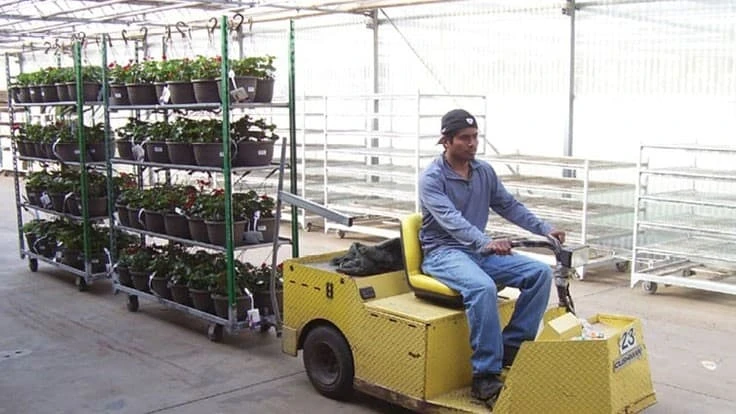

With labor difficult to find and expensive to employ, making efficient use of the employees you have is important. Training, materials handling equipment and better working conditions can help to improve output with less labor.
Provide training for new employees. Some prospective employees have never been in a greenhouse or are not familiar with the way plants are grown. New employees should be trained and provided with a broad range of experience if possible. The training can be in the form of videos on specific subjects. It can also come from working with an experienced worker that has some skill in training.
Form small teams for greater output. Many tasks require the effort of a number of individuals in a sequence of operations. The team approach usually gets the maximum output. Giving a new employee a broad range of tasks can identify natural skills. Take advantage of these when assigning work.
Employee motivation. A worker is happier with a job that satisfies basic needs. Recognition and attention for a job well done can go a long way toward building self-confidence and esteem. Assistance with family or health problems indicates that you are concerned with their welfare.
Compensation, both pay and benefits, are usually the major factor in motivation. Salary, hourly rate and piece work are used in the industry. Salary is common for supervisors and employees that have flexible hours. Tasks such as potting and transplanting are frequently compensated by piecework. Other tasks such as watering and materials handling work better on an hourly basis.

Reduce the amount of walking employees have to do. Walking adds considerable time to the cost of plants. An average time to pick up or set down a flat of plants is 1.5 seconds. Carrying or walking can be figured at 4 feet/second. At a $15/hr labor rate, making a round trip 10’ away to place a flat of plants on a bench adds 3 cents to its cost. Walking to the far end of a 100’ greenhouse costs $0.25.
Electric carts have multiple uses. Personnel carriers are characterized by a driver compartment and additional seating for employees. They can save considerable walking time in larger operations. Cargo carriers have a driver compartment and bed area for the load and are great for moving materials. Tow tractors can have either a stand-up or seat compartment and usually a very small cargo area. Select a model that fits your operation and needs.
Conveyors speed plant movement. One of the most popular types of conveyors is the multi-section conveyor. It is made up of one section with a drive unit and a number of additional sections that can be added to provide the desired length. These work well for moving pots into and out of the growing area or for loading plants onto a long truck bed. It takes about 5 to 10 minutes to set up a 75-foot unit.
Select equipment that will pace workers. A variable speed belt conveyor also works well for potting, transplanting and packaging providing uniformity and consistency. For the medium size grower that grows mainly a spring crop of annuals or holiday plants, a transplanting conveyor can give a big increase in production. Growers have reduced transplanting costs by 30 to 40% by just installing a transplanting conveyor.
For larger operations or for growers that are producing plants year-round, there is an automatic transplanter that will fit your needs. Machines are available that will plant from 10,000 to over 50,000 plants per hour. To get maximum production, the transplanter is only one piece of equipment in a system that may include a bale breaker, flat de-stacker, tray or pot dispenser, container filler, transplanter, source tray feeder, automatic tagger, watering tunnel and associated conveyors. Once the trays are transplanted, carts or conveyors are necessary to transport the 1,000 flats/hr to the growing area. This equipment is the only way large growers can fill their orders on time.
One way to offset the increasing cost of labor is to improve the efficiency of your present operations. An efficient work area and easy method for moving plants and materials are usually the areas where the greatest gains can be made.

Explore the December 2021 Issue
Check out more from this issue and find your next story to read.
Latest from Greenhouse Management
- Anthura acquires Bromelia assets from Corn. Bak in Netherlands
- Top 10 stories for National Poinsettia Day
- Langendoen Mechanical hosts open house to showcase new greenhouse build
- Conor Foy joins EHR's national sales team
- Pantone announces its 2026 Color of the Year
- Syngenta granted federal registration for Trefinti nematicide/fungicide in ornamental market
- A legacy of influence
- HILA 2025 video highlights: John Gaydos of Proven Winners





